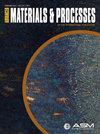机器学习:增材制造材料属性允许开发的进展
IF 0.8
4区 材料科学
Q4 MATERIALS SCIENCE, MULTIDISCIPLINARY
引用次数: 0
摘要
本文从机器学习(ML)的概述开始,探讨ML算法的特点。然后报告了最近完成的两个研究项目的结果,这些项目调查了机器学习在建立增材制造材料性能允许值方面的潜在用途。虽然需要继续进行研究和开发工作,但结果是非常有希望的。本文章由计算机程序翻译,如有差异,请以英文原文为准。
Machine Learning: Progress Toward Additive Manufacturing Materials Property Allowables Development
Abstract This article starts with a synopsis of machine learning (ML) and explores the characteristics of ML algorithms. It then reports on the results of two recently completed research projects investigating the potential use of ML to establish additive manufacturing materials property allowables. Although continued research and development work is required, the results are very promising.
求助全文
通过发布文献求助,成功后即可免费获取论文全文。
去求助
来源期刊

Advanced Materials & Processes
工程技术-材料科学:综合
CiteScore
0.40
自引率
0.00%
发文量
0
审稿时长
>12 weeks
期刊介绍:
Advanced Materials & Processes (AM&P) is the flagship publication from ASM International.
 求助内容:
求助内容: 应助结果提醒方式:
应助结果提醒方式:


